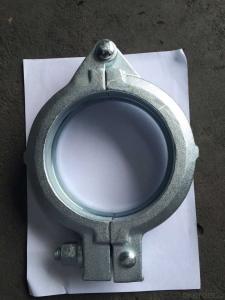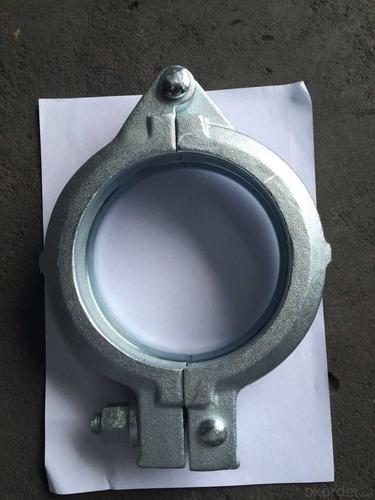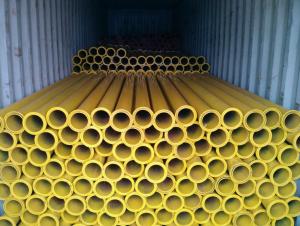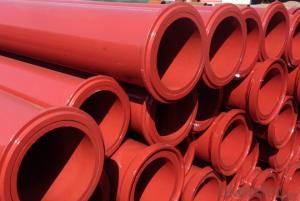Concrete Pump Bolt Clamp Coupling DN125 Forged
- Loading Port:
- China main port
- Payment Terms:
- TT OR LC
- Min Order Qty:
- 50 PCS
- Supply Capability:
- 10000 PCS/month
OKorder Service Pledge
OKorder Financial Service
You Might Also Like
Product Description:
A coupling is a device used to connect two delivery pieps together at their ends for the purpose of transmitting, and prevent the concrete from leaking. Couplings do not normally allow disconnection of shafts during operation.
Main Product Features:
1. Use high quality steel. After high-temperature 1200 forging,it’s shaped.
2.High temperature forging.
3.convenient to use, easy operation,and high safety.
4.good sealing,wear-resising,longer service life.
5.do not restrict the steering tubes, pipes during the working process can be 360 degrees rotation.
6.used in concrete pump truck,concrete pump and pipeline connection seal in construction
work equipment.
Product Specifications:
1.Forged
2.2--8 inch
3.Galvanizing/Baking varnish
4.More durable,light,beautiful
Production steps:

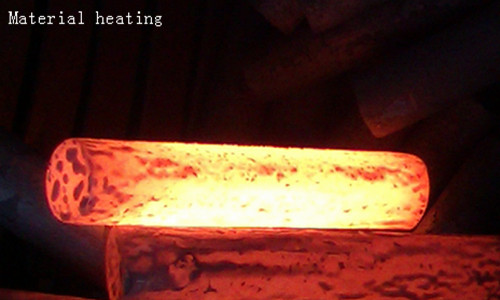
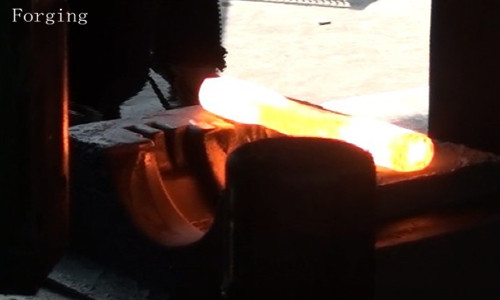
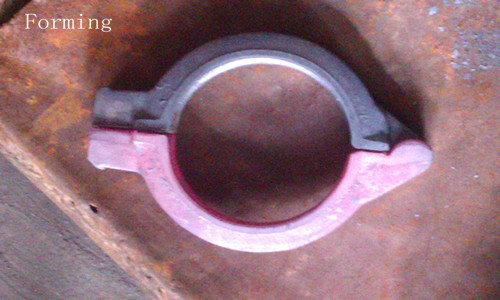
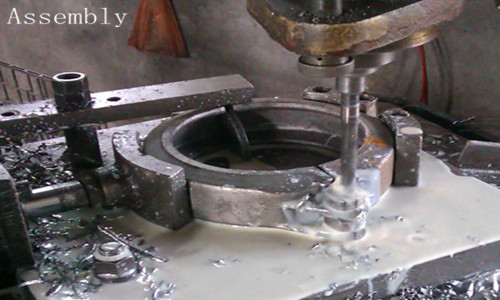
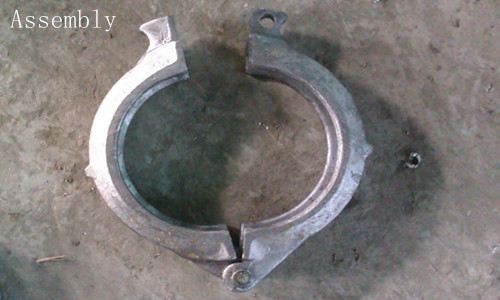
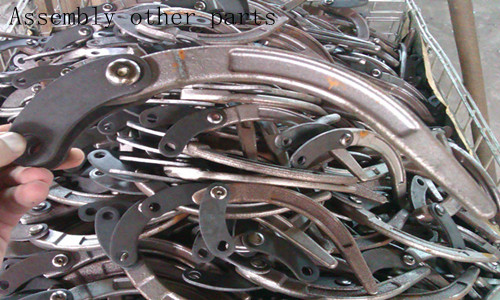
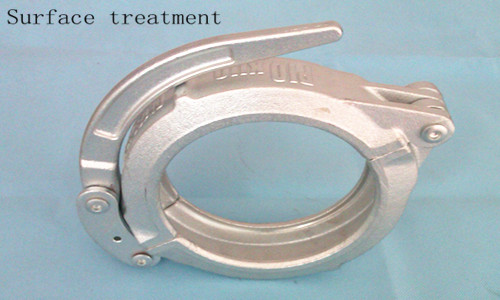
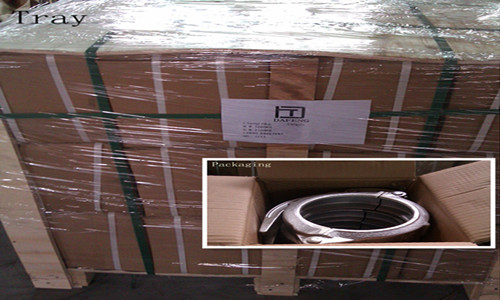
Concrete pump clamp Catalogue
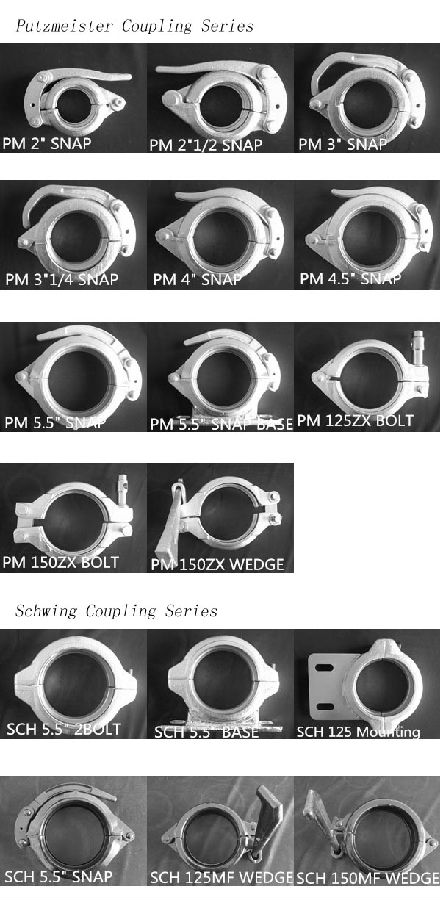
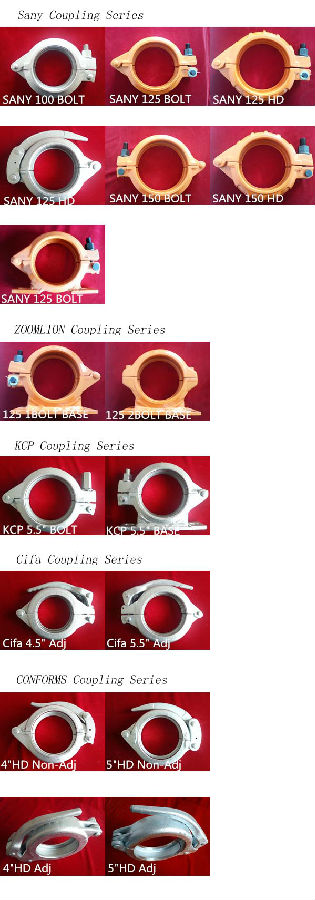
FAQ
1.How do you regarding your product quality?
As our principle is more safety to save more. In China, there are lots of manufactures of this line, but we are the first one that use the forging technic in producing, firmly meet the PM standard.
2.Can I get some samples?
Of course you can. Small sample for free, but you pay the express. For some products are not small, like concrete pump pipe, it’s very difficult to deliver one pipe of 3000mm. If it’s possible, we’d like that you can come here to visit our factory. Welcome!
3. I want to make our logo on the products, is that ok?
Yes, it’s totally ok. OME is available from us.What you should do is send your logo, brand name, or picture to us. And let other things leave on us.
- Q: What are the potential risks of using non-standard or modified hydraulic components in concrete pump spare parts?
- Using non-standard or modified hydraulic components in concrete pump spare parts can pose several potential risks. Firstly, non-standard components may not have undergone the same rigorous testing and quality control as the original equipment manufacturer (OEM) parts. This means that their performance and durability may be compromised, leading to potential failures or malfunctions. Such failures can result in accidents, injuries, or damage to the equipment or surrounding structures. Secondly, using non-standard or modified components may void the warranty of the concrete pump and its spare parts. Manufacturers typically offer warranties to ensure the reliability and safety of their products. By using non-standard components, the warranty may become null and void, leaving the user responsible for any repairs or replacements needed due to issues arising from these non-standard parts. Another risk is the potential compatibility issues that may arise when using non-standard or modified components. Hydraulic systems rely on precise engineering and compatibility between various components to function optimally. Non-standard or modified parts may not fit properly or may have different specifications, leading to leaks, pressure imbalances, or reduced overall performance. Furthermore, the use of non-standard or modified components may also impact the overall efficiency and productivity of the concrete pump. OEM parts are designed to work seamlessly with the rest of the system, ensuring smooth operation and maximum output. By using non-standard parts, the performance of the pump may be compromised, resulting in increased downtime, decreased productivity, and higher maintenance costs. Lastly, the use of non-standard or modified components may also have legal and regulatory implications. In some jurisdictions, there may be regulations or standards in place that require the use of OEM or certified parts for certain equipment, including concrete pumps. Failure to comply with these regulations can result in fines, penalties, or legal liabilities in case of accidents or failures. In conclusion, the potential risks of using non-standard or modified hydraulic components in concrete pump spare parts include compromised performance and durability, warranty voidance, compatibility issues, reduced efficiency, and legal and regulatory implications. It is always advisable to use OEM or certified spare parts to ensure the safety, reliability, and optimal performance of the equipment.
- Q: What are the different types of concrete pump hopper cylinders seals?
- Concrete pump hopper cylinder seals come in various types, each catering to specific needs and requirements. The most commonly used types are as follows: 1. Piston seals: These seals prevent leakage between the piston and cylinder bore. They are typically crafted from durable materials like rubber or polyurethane, ensuring resistance to wear and tear. 2. Rod seals: Installed on the piston rod, rod seals prevent leakage between the rod and cylinder head. They are commonly made of rubber or fabric-reinforced rubber, delivering reliable sealing even in high-pressure conditions. 3. Wiper seals: These seals are utilized to remove dirt, dust, and other contaminants from the retracting piston rod. They are usually composed of polyurethane or rubber, effectively sealing and protecting the cylinder. 4. Wear rings: Employed to decrease friction and prevent metal-to-metal contact between the piston and cylinder bore, wear rings are usually made of materials like bronze or Teflon. They significantly extend the cylinder's lifespan by reducing wear and tear. 5. Backup rings: These rings provide additional support and stability when used alongside other seals. Typically crafted from materials like rubber or PTFE, backup rings prevent extrusion and damage to the primary seal. In summary, the choice of the appropriate concrete pump hopper cylinder seal relies on factors such as the specific application, operating conditions, and desired performance characteristics. It is crucial to select seals that are compatible with the material being pumped, offer effective sealing, and have a long lifespan to ensure optimal performance and minimize maintenance needs.
- Q: How can you determine when a concrete pump hose needs to be replaced?
- There are several indicators that can help determine when a concrete pump hose needs to be replaced: 1. Visual inspection: Regularly inspect the hose for any signs of wear and tear. Look for cracks, cuts, abrasions, or bulges on the surface. If you notice any significant damage, it is a clear indication that the hose needs to be replaced. 2. Leaks: Check for any leaks in the hose. If you notice any fluid leaking from the hose, it can be a sign of deterioration or damage. Even small leaks should not be ignored as they can compromise the efficiency and safety of the concrete pumping process. 3. Reduced performance: Pay attention to any changes in the pump's performance. If you observe a decrease in the pumping pressure or flow rate, it may be due to a worn-out hose. The hose may have become stretched or worn internally, reducing its effectiveness. 4. Age and usage: Consider the age of the hose and the frequency of its usage. Over time, concrete pump hoses can deteriorate due to exposure to chemicals, weather conditions, and the constant pressure they are subjected to during operation. If the hose is older or has been used extensively, it may be nearing the end of its lifespan. 5. Manufacturer's recommendations: Consult the manufacturer's recommendations regarding the lifespan or replacement intervals for the concrete pump hose. Manufacturers often provide guidelines on when hoses should be replaced based on their specific materials and construction. Ultimately, it is crucial to prioritize safety and reliability when determining whether to replace a concrete pump hose. If there are any doubts about the integrity of the hose, it is best to err on the side of caution and replace it to avoid potential accidents or disruptions in the concrete pumping process.
- Q: How to operate the concrete pump?
- The size of sand and gravel, cement mark and mixture ratio should meet the requirement of the mechanical performance of the pump according to the specifications of the factory
- Q: How do I find the right part number for a specific concrete pump spare part?
- To find the right part number for a specific concrete pump spare part, you can follow these steps: 1. Start by identifying the make and model of your concrete pump. This information is usually found on the pump itself or in the product documentation. 2. Once you have the make and model, visit the manufacturer's website or contact their customer support directly. They will typically have a parts catalog or database where you can search for the specific part you need. 3. Use the provided search tool or browse through the catalog to find the section related to your concrete pump model. Look for the parts that match your description or function. 4. Pay attention to the part numbers listed alongside the descriptions. These numbers are usually unique identifiers for each specific part. Make note of the part number(s) that match the spare part you require. 5. If you are unable to find the required part number on the manufacturer's website or catalog, consider reaching out to authorized dealers or distributors of the concrete pump brand. They may have additional resources or access to parts that are not readily available elsewhere. By following these steps and utilizing the manufacturer's resources, you should be able to find the right part number for your specific concrete pump spare part.
- Q: Can concrete pump spare parts be installed by the pump owner or operator, or is professional assistance required?
- Concrete pump spare parts can be installed by the pump owner or operator, but it is highly recommended to seek professional assistance. Installing concrete pump spare parts requires technical knowledge and expertise to ensure proper installation and functionality. Professional assistance ensures that the spare parts are correctly installed, minimizing the risk of damage or malfunction. Additionally, professionals have the necessary tools and equipment to handle the installation process safely and efficiently. Investing in professional assistance not only guarantees a successful installation but also contributes to the longevity and optimal performance of the concrete pump.
- Q: How do I properly maintain and replace filters in concrete pump spare parts?
- To ensure optimal performance and longevity of your equipment, it is crucial to properly maintain and replace filters in concrete pump spare parts. Here are some guidelines to follow: 1. Get familiar with the different types of filters: Concrete pumps have various filters for hydraulic oil, fuel, air, and water. Take the time to understand which filters are used in your equipment. 2. Consult the manufacturer's instructions: Read the equipment manual and adhere to the guidelines provided by the manufacturer regarding filter maintenance and replacement intervals. This will ensure that you are following the recommended practices. 3. Conduct regular filter inspections: Periodically check the filters for signs of damage, clogging, or excessive debris accumulation. You can visually inspect them or measure the pressure differential across the filter. If the pressure differential exceeds the recommended limit, it may be necessary to replace the filter. 4. Clean or replace filters as required: If the filters are clogged or dirty, they should be cleaned or replaced. Some filters can be cleaned by blowing compressed air in the opposite direction of the airflow to remove debris. However, it is important to note that certain filters are disposable and cannot be cleaned. 5. Use authentic spare parts: When replacing filters, always opt for genuine spare parts recommended by the manufacturer. This ensures compatibility and performance. 6. Follow proper handling and installation procedures: When installing new filters, make sure to handle them with clean hands or wear gloves to prevent contamination. Follow the correct installation procedure, such as tightening the filter housing to the recommended torque value. 7. Maintain a regular maintenance schedule: Establish a consistent schedule for filter inspection, cleaning, and replacement. This will help you stay on top of filter maintenance and prevent potential issues caused by dirty or clogged filters. By adhering to these steps, you can effectively maintain and replace filters in concrete pump spare parts, ensuring efficient equipment operation and an extended lifespan.
- Q: How can one determine the correct pressure and flow rating for hydraulic components in concrete pump spare parts?
- To determine the correct pressure and flow rating for hydraulic components in concrete pump spare parts, several factors need to be considered: 1. Manufacturer's specifications: Review the manufacturer's specifications for the hydraulic components. The specifications should include the recommended pressure and flow ratings for optimum performance and durability. 2. System requirements: Assess the specific requirements of the concrete pump system. Consider factors such as the size of the pump, the volume and distance of concrete being pumped, and the speed at which the concrete needs to be delivered. These factors will help determine the required pressure and flow rating for the hydraulic components. 3. Safety considerations: Ensure that the pressure and flow rating of the hydraulic components are within the safe operating limits of the concrete pump system. Exceeding these limits can lead to equipment failure, accidents, or damage to the components. 4. Compatibility: Verify that the hydraulic components are compatible with the rest of the system. The pressure and flow rating should match the capabilities and specifications of other components such as the pump, valves, and hoses to ensure proper functionality and performance. 5. Consultation with experts: If unsure about the appropriate pressure and flow rating for hydraulic components, consult with hydraulic system experts or the manufacturer's technical support team. They can provide guidance based on their expertise and experience with similar systems. It is important to note that the pressure and flow rating of hydraulic components may vary depending on the specific model, design, and intended application. Therefore, it is crucial to refer to the manufacturer's guidelines and recommendations to ensure accurate determination of the correct pressure and flow rating for hydraulic components in concrete pump spare parts.
- Q: What are the signs of a malfunctioning concrete pump outrigger?
- Some signs of a malfunctioning concrete pump outrigger may include uneven or unstable operation, difficulty in extending or retracting the outriggers, leaks or hydraulic fluid drips, unusual noises during operation, or visible damage or wear on the outrigger components. It is important to address any signs of malfunction promptly to ensure safe and efficient operation of the concrete pump.
- Q: Are there any specific troubleshooting steps for identifying issues with concrete pump spare parts?
- Concrete pump spare parts can be identified for issues by following specific troubleshooting steps. These steps include conducting a thorough visual inspection of the spare parts to look for signs of wear, damage, or misalignment. Cracks, breaks, or any visible signs of damage should be checked for. The functionality of the spare parts can be tested by operating the concrete pump and paying attention to abnormal noises, vibrations, or irregular movements. A pressure test can be performed by connecting a pressure gauge to the pump and checking if it reaches the desired pressure levels. Any abnormal pressure fluctuations can indicate issues. A flow test can be conducted to evaluate the flow rate of the concrete through the pump and check for any blockages or irregular flow patterns. The spare parts should be inspected for leaks or fluid seepage, which can indicate faulty seals, gaskets, or fittings. Technical manuals provided by the manufacturer can be consulted for troubleshooting guidelines specific to the concrete pump spare parts. If unable to identify the issue, it is advisable to seek expert advice from a qualified technician or the manufacturer's technical support team. By following these troubleshooting steps, it becomes easier to promptly identify and address any issues with concrete pump spare parts.
Send your message to us
Concrete Pump Bolt Clamp Coupling DN125 Forged
- Loading Port:
- China main port
- Payment Terms:
- TT OR LC
- Min Order Qty:
- 50 PCS
- Supply Capability:
- 10000 PCS/month
OKorder Service Pledge
OKorder Financial Service
Similar products
Hot products
Hot Searches
Related keywords
